This post may contain affiliate links. Please read our disclosure policy.
With a wide variety of onions available for purchase, it can be hard to figure out what type of onion you should use in any given recipe. Onions are used in so many recipes, from soups, fresh and cold salads, sauces, and dressings, to braised dishes, baked goods, and even fried on their own. So the next time you’re strolling the produce aisle wondering which type of onion is best, consider what you learn here and be sure to save the Onion Chart for easy reference.
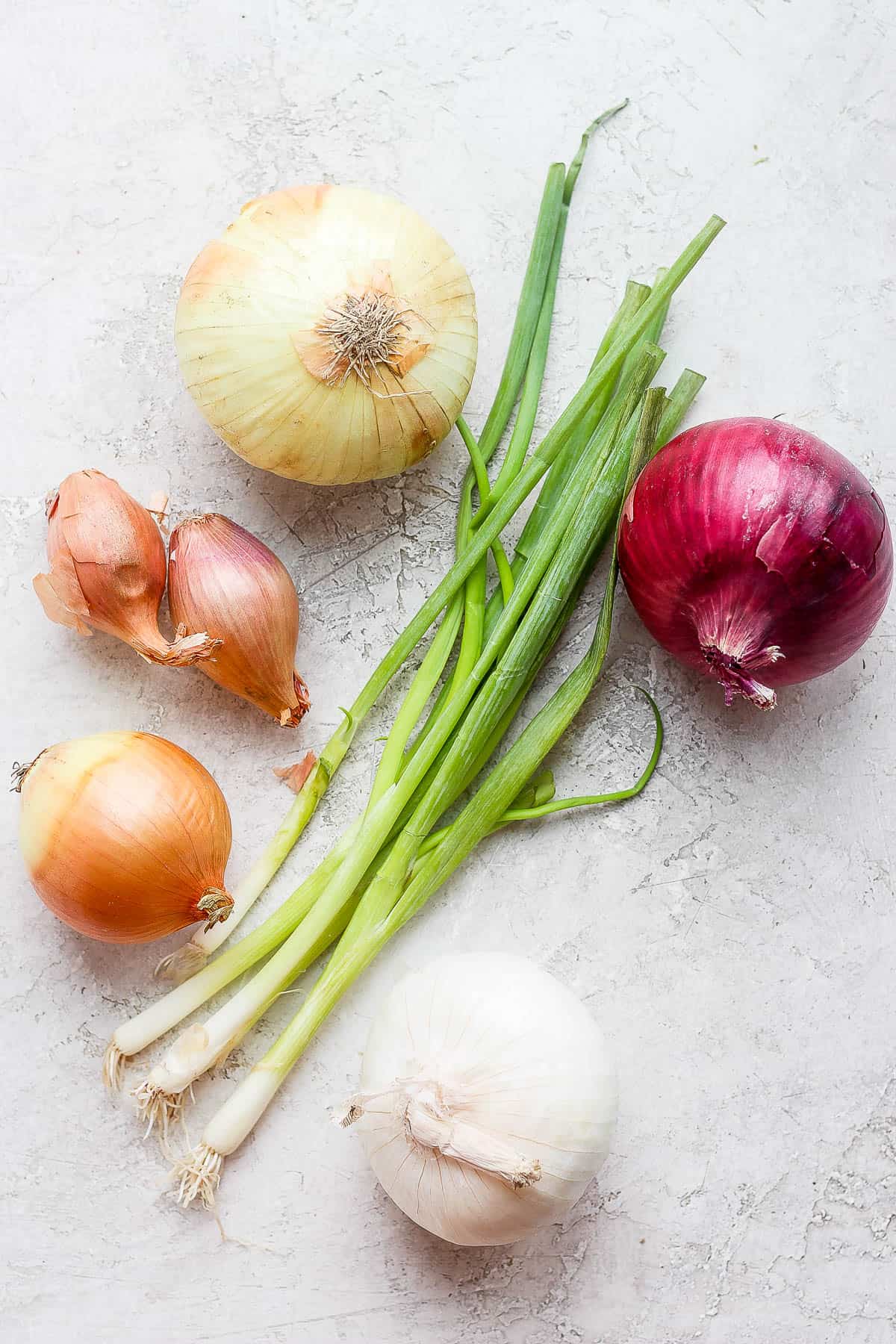
Table of Contents
This guide covers 6 types of onions, their uses, how best to select and store them, and a few recipes using each type of onion.
A brief history of onions
Did you know that the onion dates back further than we can track? It’s believed that wild onions were first utilized for medicine and cooking over 5000 years ago. However, it’s challenging to pinpoint its origin to either Asia or Northern Africa, namely Pakistan, where you first see onions traded and cultivated. Check the ancient Egyptian walls, and you’ll find how prized the onion is!
Onions can grow in almost any soil or climate, designating them to be one of the best biennial crops that are easy to grow and are less perishable than most vegetables. Today, onions are one of the most widely used aromatics in cuisines worldwide, utilized in their raw form and cooked in various ways.
What are the benefits of eating onions?
- Add immense flavor to your dishes. This culinary marvel enhances any recipe with incredible taste and depth. Onions are found in every cuisine, adding varying levels of umami to any recipe.
- Boost your immunity with raw onions. The age-old practice of eating raw onions is an excellent way to help control blood sugar, lower blood pressure, and have a high dose of anti-inflammatory properties. And yes, cooked onions still hold on to these health benefits, too!
- Full of fiber. When added to other recipes with fiber, onions support digestion with a healthy dose of prebiotic fiber, vitamins, and minerals.
how many types of onions are there?
Onions are one of the largest plant genera with hundreds of different species, but 6 types of onions are most common for the home cook: yellow, white, sweet, red, shallots, and green onions.
Types of Onions Chart
Here’s a quick look at the 6 most popular onion types that include facts about their flavor profile and what recipes they’re best in. Be sure to save this for later for a quick reference.

6 different types of onions & Their Uses
Let’s go a little more in-depth on the most popular onion varieties available to the average home chef and found in any produce store. Below I’ll cover each onions uses, how best to store them, what to look for in an onion when purchasing, and the best recipes to use each type of onion. Once you choose your onion, use this guide on how to cut an onion to get started on your recipes!
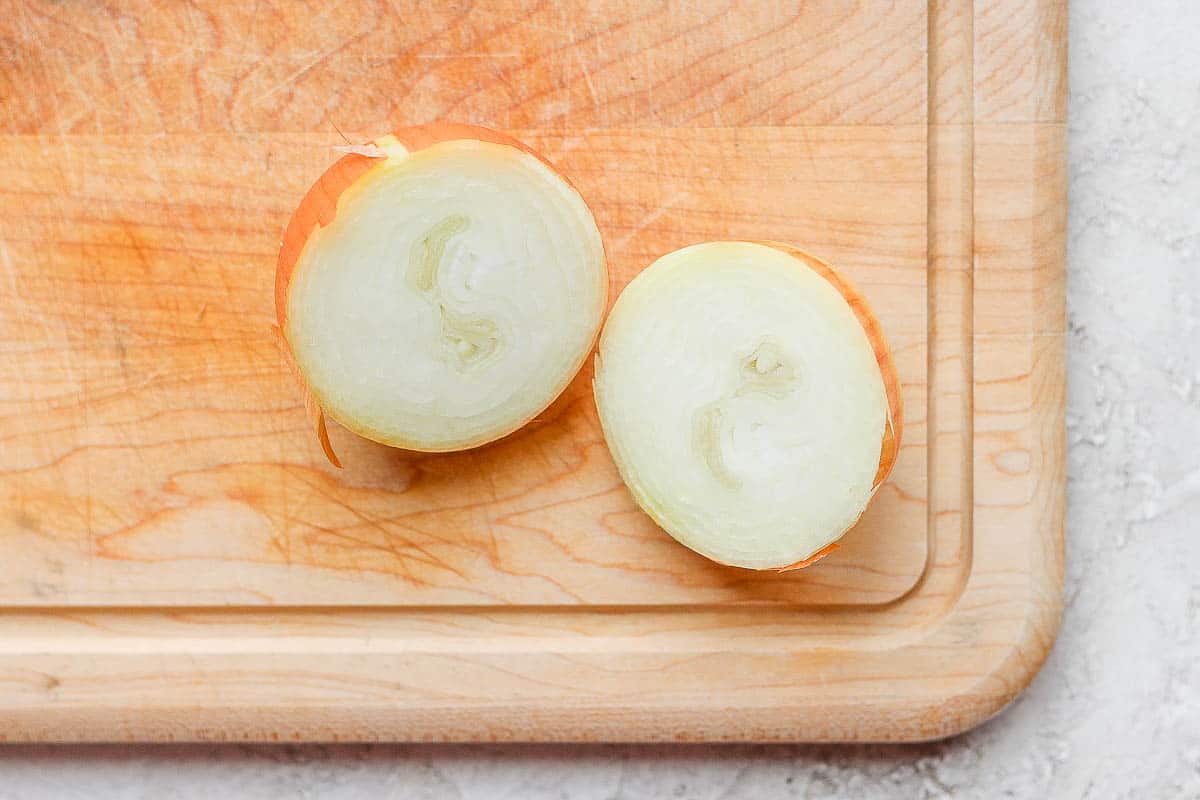
Yellow onions
This is the most common onion, covered in a brownish-yellow papery skin. Yellow onions can be almost as small as a golf ball or as big as a grapefruit. While they have a strong, pungent flavor when raw, they become sweeter when cooked down.
- Uses: Considered too intense to eat raw, these flavorful gems prove best in cooked recipes. You can dice, slice, chop, or mince onions and use different cooking methods such as sauteing, braising, pan frying, caramelizing, or grilling. Use in recipes such as dips, soups, stews, sauces, stir-fries, meat roasts, and more.
- Best way to store yellow onions:
- Whole yellow onions should be kept with their skin on at room temperature in a cool, dry, and well-ventilated location, away from direct heat and humidity, lasting up to 3 months when properly stored.
- Once prepared, store cut onions in an airtight container in the fridge for 7-10 days.
- Freeze cut onions by spreading them in an even layer on a cookie sheet and freezing until solid before transferring them to an airtight container and storing up to 6 months. This makes it easier to portion out recipes.
- What to look for when buying yellow onions: For the freshest yellow onions, pick ones that are heavy, firm, and have no soft spots with dry, papery skins.
- Recipes that use yellow onions: caramelized onions, French onion dip, classic French onion soup, grilled lamb kabobs, eggplant stew, or beef kafta, to name a few, but again, yellow onions can be used in almost any recipe that calls for onions!
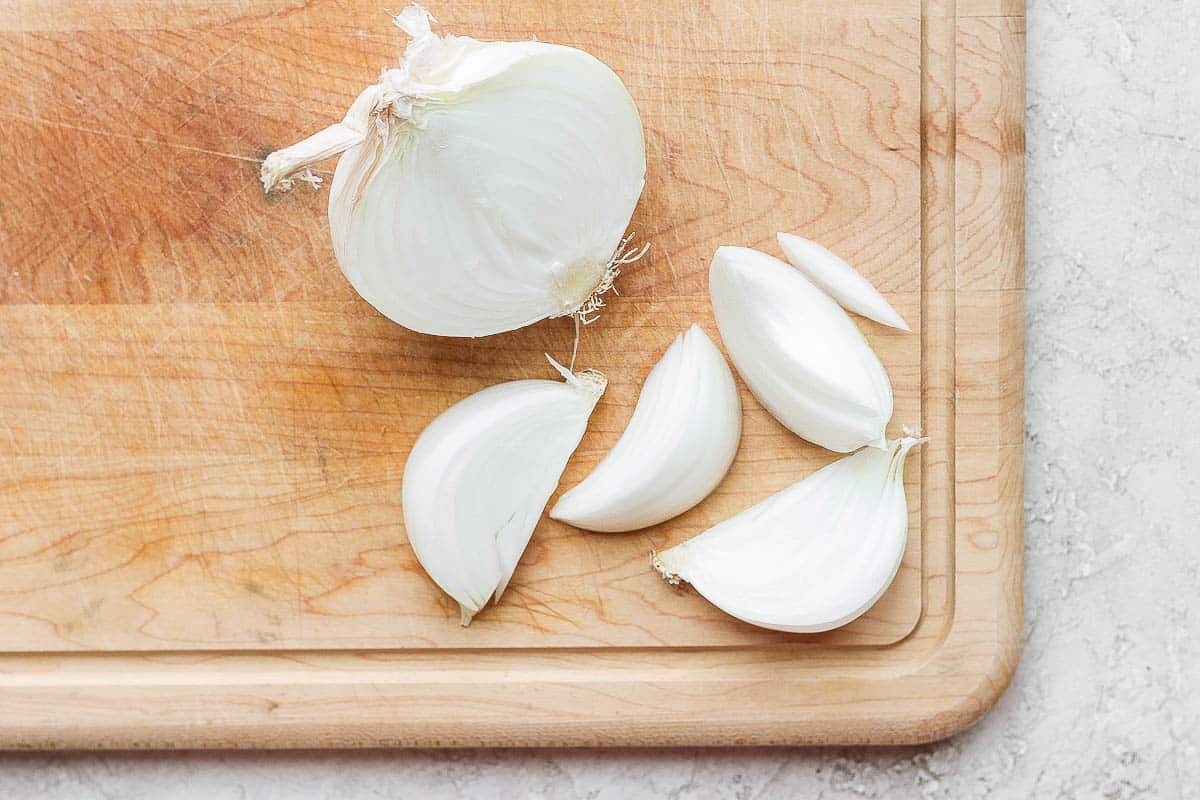
White onions
Usually orange to grapefruit-sized, this type of onion is covered in bright white skin. Although generally considered slightly sharper in taste than yellow onions, many people can not tell the difference.
- Uses: Use white onions the same way you would yellow ones, but are sharper and crunchier, perfect to be eaten raw in salsas, guacamole, or sandwiches or minced as a topper for sausages and hot dogs.
- Best way to store white onions:
- Whole white onions store well at room temperature in a cool, dry, and well-ventilated location, away from direct heat and humidity, lasting up to 3 months.
- Once prepared, store cut white onions in an airtight container in the fridge for 7-10 days.
- You can freeze cut white onions up to 6 months to use in cooked recipes, but best to use fresh white onions if using them raw.
- What to look for when buying white onions: When choosing white onions, look for ones that are heavy, firm, and have no soft spots with dry, papery skins.
- Recipes that use white onions: homemade salsa, butternut squash risotto, homemade vegetable stock, and chicken stock.
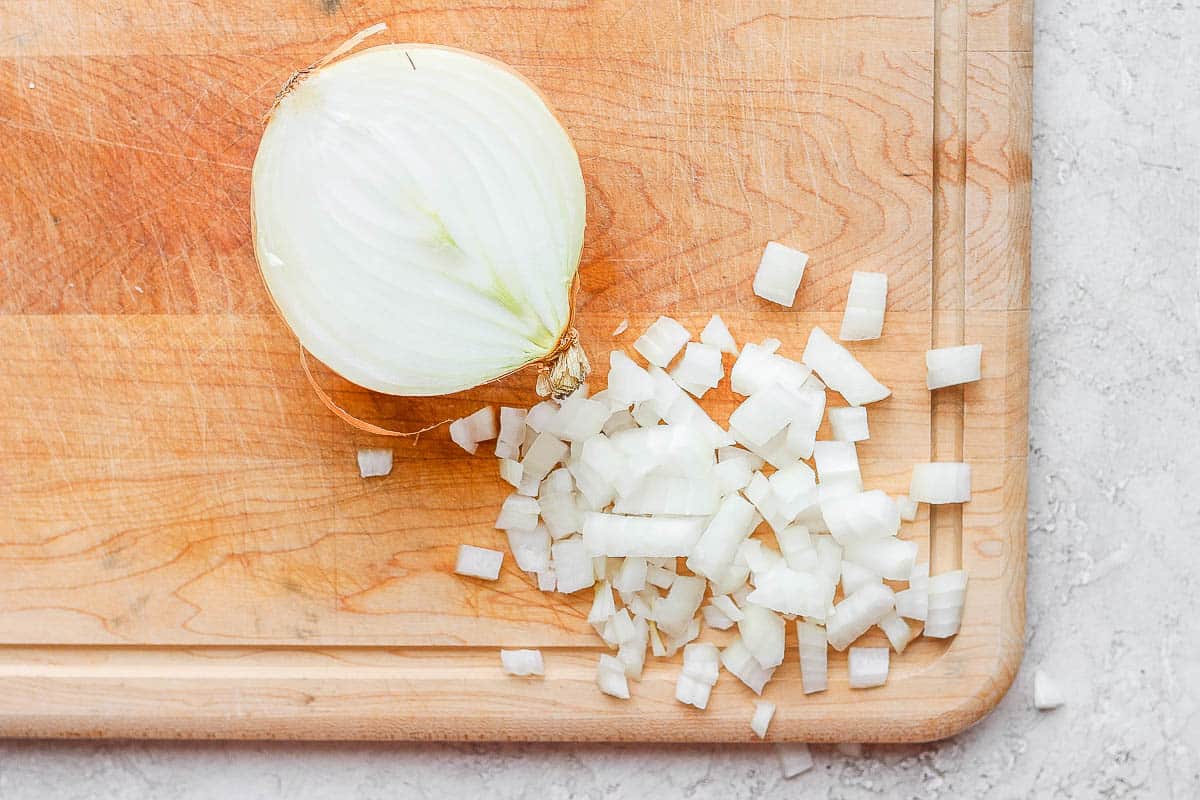
Sweet onions
The common varieties -Vidalia, Walla Walla, Maui – look almost identical to yellow but have a more squished shape, as if someone took a round ball and smooshed it down.
- Uses: Their extra sweetness (they actually have about the same amount of sugar but less bitterness than yellow onions) makes them good to eat raw, batter up for onion rings, roasting, in red sauces, or grilled as a side dish.
- Best way to store sweet onions:
- Whole sweet onions should be kept at room temperature in a cool, dry, and well-ventilated location, away from direct heat and humidity, lasting up to 3 months when properly stored.
- To store cut sweet onions, keep them in an airtight container in the fridge for 7-10 days.
- Freeze cut onions by spreading them in an even layer on a cookie sheet and freezing until solid before transferring them to an airtight container and storing up to 6 months.
- What to look for when sweet onions: Choose sweet onions free of bruising, heavy, and devoid of mold. Sweet onions are a bit softer than other onion varieties and easy to spot by gently pressing your fingernail into the side. If they’re fresh and leave an indention, it’s likely sweet. You’ll also notice the skin to be similar to yellow and white onions but a little smoother.
- Recipes that use sweet onions: grilled onions, marinara sauce, eggplant parmesan, tomato lentil soup, and green bean casserole.

Red/Purple onions
This type of onion is the pretty purple one. Named “red onions” because their skins were used to make red dyes but they are known for their big flavor.
- Uses: Eat purple onions raw, in salads or guacamole, or pickle them. They are yummy grilled or caramelized. (They are the onion of choice for the caramelized onions on BBQ Chicken Pizza.) Beware, though; the subtler flavor tends to disappear in stews and soups.
- Best way to store red/purple onions:
- Whole red onions should be kept at room temperature in a cool, dry, and well-ventilated location, away from direct heat and humidity, lasting up to 3 months when properly stored.
- Once prepared, store cut red onions in an airtight container in the fridge for 7-10 days.
- You can freeze cut red onions up to 6 months for using in cooked recipes, but best to use fresh red onions if using raw.
- What to look for when buying red/purple onions: For the freshest red onions, pick ones that are heavy, firm, and have no soft spots with dry, papery skins.
- Recipes that use red/purple onions: pickled onions, guacamole, tuna salad, burrito bowls, chicken pizza, roasted veggie grain bowls, vegan chili, or on smoked salmon bagel.
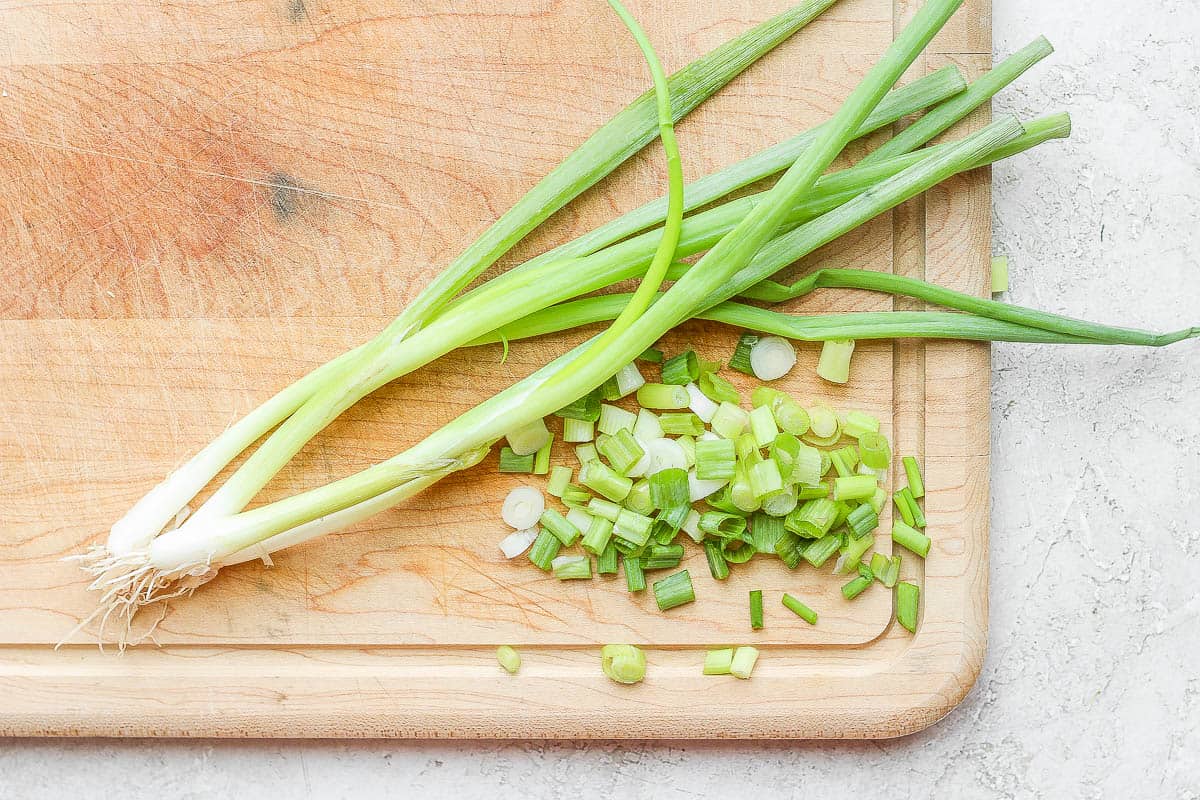
Green onions/scallions
Scallions and green onions are the same thing. They have a white small bulb at the end with tiny tendril roots attached. As their stalk lengthens, it turns dark green. The related spring onion looks almost the same but has a larger, rounded bulb at the end. Here’s a quick guide on the best way to cut green onions.
- Uses: A mainstay in Asia and Latin America, great for eating raw in salads (Chinese chicken salad!) or as a garnish on noodles or cooked dishes. Also fantastic grilled whole. Excellent in marinades and salad dressings. If cooking, add last and cook quickly.
- Best way to store green onions/scallions:
- Store green onions in the crisper drawer, gently wrapped in a damp paper towel in a sealed container or ziptop bag. You want to keep them moist, which is unlike most onion varieties.
- Another way to keep green onions/scallions fresh is to keep the roots in water. Place a jar in the kitchen away from direct heat. Not only will they stay super fresh, but they’ll also continue to grow! You can use the regrowth a few times, but eventually, the flavor won’t be as potent and, at this time, can be tossed.
- What to look for when buying green onions/scallions: To pick the best green onions, choose ones that have firm white bulbs and fresh vibrant leaves. Avoid soft spots and wilting.
- Recipes that use green onions/scallions: Lebanese tabbouleh salad, red curry noodle soup, cabbage salad, potato salad, stuffing, frittata, and for topping baked potatoes, appetizers, soups and stews.
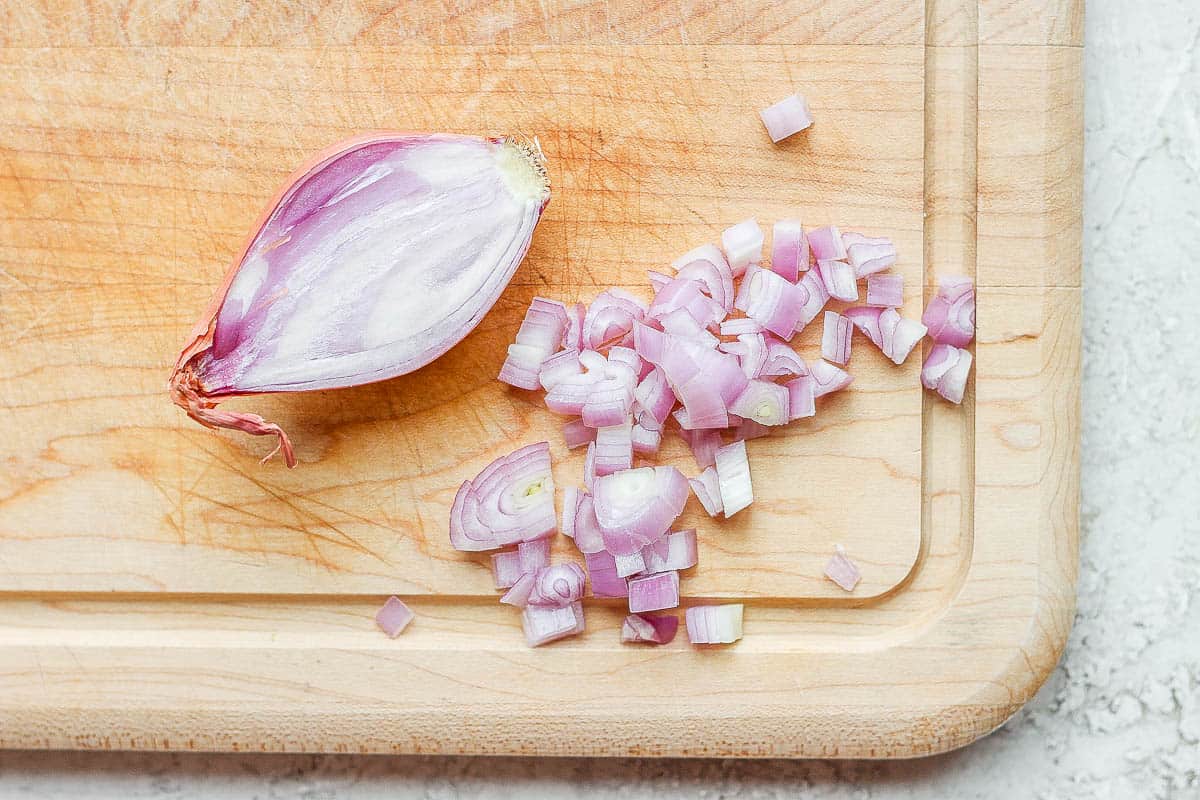
Shallots
Reddish-brown, crescent-shaped alliums and shallots look like oversized cloves of garlic
- Uses: Popular in French cooking, shallots are milder and a little sweeter than yellow onions but can be substituted for them. Shallots are fantastic for quick pickling and use in sandwiches and salad dressings. Peel and roast whole for sheet pan meals. raw garnish, slow-cooked, or braised. Also, check out this quick-cutting tutorial for prepping shallots.
- Best way to store shallots:
- The best way to store shallots is in a paper bag or hanging basket with plenty of air circulating through. Keep them in a dry area for a longer shelf life of up to 2 months.
- Whole shallots can be refrigerated for up to 2 weeks, while cut shallots should be stored in an airtight container in the fridge and will last up to 7-10 days.
- Just like other onion varieties, you can freeze shallots for up to 6 months to use in cooked recipes.
- What to look for when buying shallots: When choosing shallots for purchase, pick ones that are firm and heavy with no soft spots. Avoid shallots that are sprouting, dry, or light as they have reached their peak and already starting to reach their max storage age.
- Recipes that use shallots: whole roasted chicken, salad dressing, cheesy scalloped potatoes, savory oatmeal with egg, chickpea ‘tuna’ salad, or orzo salad.
FAQs
Yes, sprouted onions are safe to eat, though they may be a tad bitter. While the new sprout grows, all the energy and sugars are targeted at the new growth. Use the onion soon and toss once the bulb begins to become soft, mushy, or have a strong odor.
Vidalia and Walla Walla are the most common and sweetest onion. It doesn’t have the sharp acidic flavors of other onions and is very palatable when eaten raw.
White onions is easily the strongest of them all and are found in Mexican and Asian cuisine with big flavors. Because of their strong flavor, white onions are perfect for dehydrating into onion powder.
The all-around winner for taste and versatility is the yellow onion. They are the standard when a recipe calls for onion but doesn’t specify what type to use.
Just about every cooking method is ideal for preparing onions. Enjoy them raw, sauteed, roasted, and grilled, and build bases for soups, stews, and sauces, or pickle them for a tangy topping. As one of the most versatile and universal ingredients in culinary, you can’t go wrong with using onions in your recipes.

Picking the right onion for your recipe is much easier once you learn its flavor profile. You can find all 6 types of onions in this guide in grocery stores, making them the most popular varieties out there. Whether using them as a fresh raw ingredient or cooking them to highlight their flavors even more, you’ll find the exact onion type you need to make whatever recipe you like.
For more Ingredient Guides:
- Salt Guide: Types Of Salt For Cooking
- Essential Cooking Spices
- Summer Produce Guide
- Protein Powder Guide For Beginners
For kitchen organization guides:
- How to Stock your Pantry
- How to Stock a Freezer
- Food Storage Tips
- How to Make Freezer Meals for Families
- How to make your kitchen more efficient
Do you have a favorite onion? Or a favorite way to protect your eyes when chopping them?
If you find this guide on onions helpful, I’d love to hear from you! And if you snapped some shots of any of these tips and tricks or recipes with protein powder, please share it with me on Instagram so I can repost on my stories!